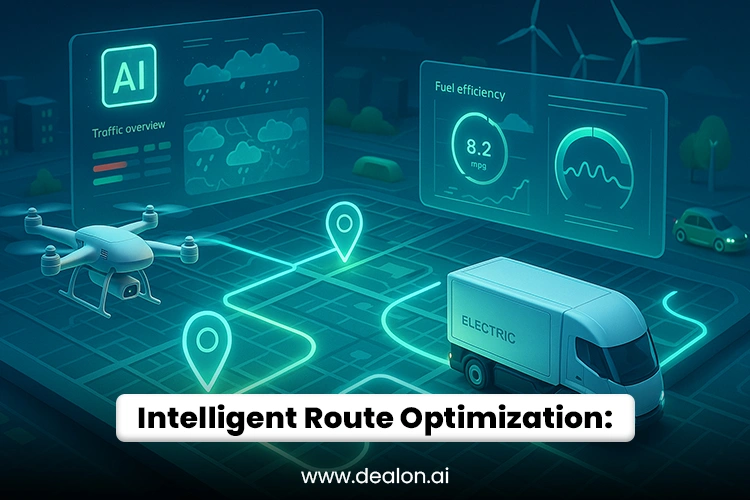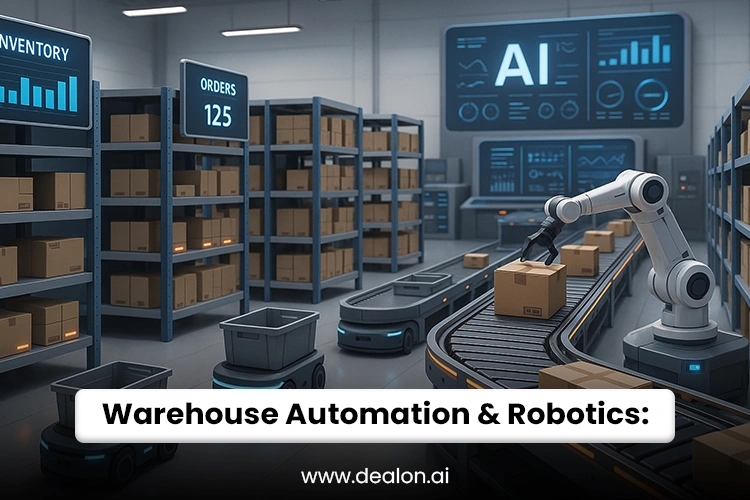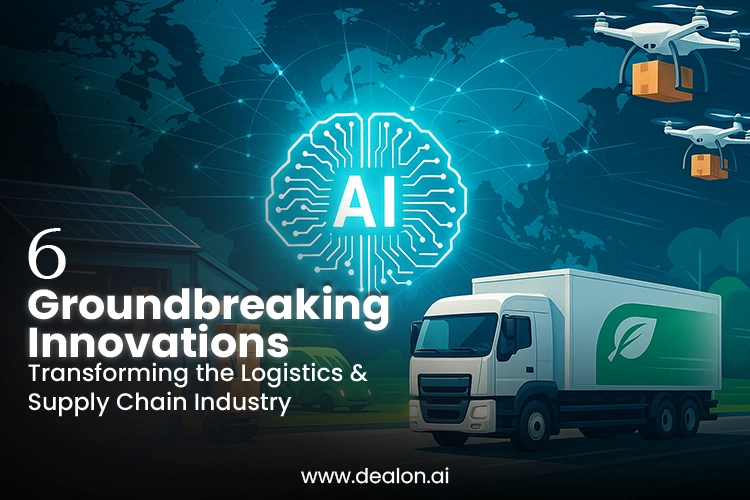In today’s highly interconnected global economy, the logistics and supply chain sector acts as the backbone of trade, ensuring the efficient flow of goods across countries, time zones, and marketplaces. Yet, this intricate web of processes has historically been riddled with inefficiencies, fragmented communication, and reactive decision-making. Enter Artificial Intelligence (AI), a technological disruptor that is not only streamlining operations but also revolutionizing the very fabric of supply chain management.
AI’s transformative impact on logistics lies in its ability to convert vast quantities of disparate data into actionable, real-time insights. No longer confined to rudimentary automation or rule-based algorithms, modern AI harnesses advanced machine learning, predictive analytics, and computer vision to orchestrate intelligent decision-making at every link of the supply chain. From anticipating demand fluctuations to optimizing last-mile delivery, AI is enabling businesses to operate with a level of agility, foresight, and precision previously unimaginable.
Furthermore, as sustainability, cost-efficiency, and risk mitigation take center stage in global commerce, AI is becoming a strategic asset for companies striving to future-proof their logistics frameworks. Integrating AI-driven tools allows for proactive disruption management, ethical sourcing, and real-time supply chain visibility, setting new standards for operational excellence.
This blog delves into six groundbreaking innovations that AI is introducing to the logistics and supply chain sector, each serving as a testament to how technology, when wielded responsibly, can transform a traditionally rigid industry into an innovative, adaptive, and sustainable ecosystem. Whether you’re a supply chain strategist, tech enthusiast, or business leader, understanding these AI-driven advancements is crucial to staying ahead in an era where data and intelligence define competitive advantage.
Also Read: AI for Green Architecture: How AI is Designing Tomorrow’s Sustainable and Energy-Efficient Cities
Predictive Demand Forecasting: AI’s Crystal Ball for the Supply Chain

Forecasting customer demand is fundamental to achieving operational efficiency in logistics and supply chains. Traditional forecasting methods—often reliant on static historical data and linear models—fail to capture the volatility of modern markets. Enter AI-powered predictive demand forecasting, a paradigm shift that leverages machine learning to deliver real-time, adaptive, and highly granular insights.
AI’s ability to ingest and interpret multidimensional datasets is at the heart of this innovation. These include sales history, seasonality, and dynamic variables such as social media trends, weather patterns, promotional calendars, geopolitical shifts, and economic indicators. The system detects patterns and correlations invisible to human analysts through deep learning algorithms, offering forward-looking projections that continuously refine themselves as new data streams.
The practical implications are transformative. With accurate demand forecasts, companies can optimize inventory levels, align procurement with actual needs, and eliminate costly scenarios such as stockouts, surplus warehousing, or last-minute expedited shipping. Retailers can adjust shelf space intelligently, manufacturers can fine-tune production schedules, and distributors can proactively allocate fleet resources, enhancing best effectiveness and service quality.
Moreover, predictive demand forecasting supports strategic agility. Businesses can model various demand scenarios, simulate disruptions, and evaluate the effect of the latest product launches or marketing campaigns. This empowers decision-makers to shift from reactive to proactive strategies anchored in data-backed certainty.
As consumer behavior becomes increasingly erratic and supply chain complexity grows, AI-powered forecasting becomes indispensable. It augments human decision-making and establishes a foundation for autonomous, self-correcting supply networks—paving the way for a future where demand is not just forecasted but intelligently orchestrated in real-time.
Intelligent Route Optimization: AI Steering Logistics Toward Precision and Sustainability

In the modern logistics landscape, efficiency is no longer defined by speed alone—it’s a delicate balance between punctuality, cost-efficiency, and environmental responsibility. This balance is masterfully orchestrated by AI-powered intelligent route optimization, a game-changing innovation that reimagines how goods move through global supply chains.
Unlike traditional routing systems that rely on static maps and fixed schedules, AI-based route optimization engines leverage real-time data streams to generate the most efficient delivery paths. These algorithms assimilate diverse variables—live traffic conditions, weather forecasts, vehicle performance metrics, road closures, and customer-specific delivery time windows—to dynamically compute the optimal delivery route. The result is a system that is not just reactive but predictively adaptive, recalibrating in real time to avoid delays and ensure uninterrupted service.
This level of precision delivers tangible benefits. Logistics providers can dramatically reduce fuel consumption, lowering operational costs and minimizing carbon emissions—key factors in advancing green logistics initiatives. Fleet utilization improves, driver fatigue decreases, and last-mile delivery becomes more predictable, ultimately enhancing customer satisfaction and supply chain reliability.
Beyond cost savings, intelligent route optimization supports resilience in volatile conditions. Whether facing urban congestion, extreme weather, or geopolitical disruptions, AI enables logistics operators to reroute in milliseconds, transforming adversity into agility proactively.
Innovations in this field also integrate machine learning feedback loops, where delivery outcomes refine future routing decisions. Coupled with geospatial analytics and telematics, AI is building a foundation for autonomous logistics ecosystems, where human oversight is enhanced by intelligent systems capable of making contextual decisions on the fly.
Warehouse Automation and Robotics: AI Empowering the Next-Gen Fulfillment Ecosystem

Once reliant on manual labor, static workflows, and paper-based processes, the traditional warehouse has radically transformed by integrating AI-powered automation and robotics. These cutting-edge technologies form the backbone of smart warehouses, where intelligence, efficiency, and adaptability converge to drive operational excellence.
This transformation’s core is the AI-driven Warehouse Management System (WMS), a centralized command hub that orchestrates real-time decision-making across the warehouse floor. Using advanced algorithms and IoT-enabled sensors, AI optimizes storage allocation, inventory tracking, and task prioritization with unparalleled precision. Every square foot of space is utilized strategically, and workflows are continuously reconfigured based on order volumes, inventory turnover, and peak periods.
Robotics further amplifies warehouse efficiency. Autonomous mobile robots (AMRs) and robotic arms handle everything from bin-to-person picking and automated shelving to sorting and packaging, reducing dependency on manual intervention and eliminating errors caused by fatigue or oversight. These robotic systems can function continuously, 24/7, making warehouses faster, safer, scalable, and resilient in fluctuating demand.
Additionally, AI enables predictive maintenance of robotic equipment, using data analytics to anticipate mechanical failures and minimize downtime. This ensures sustained productivity and cost-effectiveness, especially in high-volume e-commerce and retail environments.
Its capacity to learn and adapt sets AI apart in warehouse automation. Machine learning models continuously analyze operational data to refine picking strategies, forecast labor needs, and adjust robotic workflows in real-time, ushering in a new era of autonomous logistics.
As consumer expectations accelerate and supply chains become more dynamic, AI-powered warehouse automation offers the ultimate competitive edge, turning fulfillment centers into intelligent ecosystems capable of meeting modern demands with speed, accuracy, and agility.
Real-Time Supply Chain Visibility: AI Illuminating the Logistics Landscape
Real-time visibility has become a strategic imperative in an era where supply chain disruptions can reverberate across continents. Today’s globalized logistics networks demand transparency, responsiveness, and precision—capabilities made possible through AI-enabled, data-integrated ecosystems that deliver full-spectrum visibility across the supply chain.
AI-powered platforms harness data from various sources, including IoT sensors, GPS trackers, RFID tags, telematics systems, and ERP software, to construct a live, 360-degree operational view. This convergence of technologies allows businesses to track shipments at every node—from warehouse to transit to delivery—while monitoring environmental conditions such as temperature, humidity, and vibration to ensure product integrity, especially in sensitive industries like pharmaceuticals or perishables.
Beyond simple tracking, AI transforms raw data into actionable intelligence. It detects anomalies, forecasts delays, and recommends optimal routes or alternate suppliers in real-time. With the support of predictive analytics, organizations can identify bottlenecks before they escalate, mitigate risks such as theft or spoilage, and dynamically reallocate resources to maintain service continuity.
Moreover, real-time visibility facilitates collaborative logistics by ensuring all stakeholders—from manufacturers and carriers to retailers and end customers—access synchronized, transparent information. This heightened level of trust and coordination reduces errors, improves compliance, and accelerates response times.
AI also enables exception-based management, where systems autonomously handle routine processes and escalate only critical deviations to human operators, enhancing operational focus and efficiency. In supply chain control towers, these intelligent dashboards deliver deep situational awareness at a glance, enabling data-driven decisions that are both timely and strategic.
Ultimately, real-time supply chain visibility powered by AI is not just about knowing where things are—it’s about empowering agility, reducing uncertainty, and transforming the supply chain into a responsive, intelligent organism capable of thriving in a volatile global environment.
Smart Procurement and Supplier Risk Management: AI Empowering Strategic Sourcing
In the dynamic landscape of global commerce, procurement is no longer a back-office function—it is a strategic engine for resilience, value creation, and competitive advantage. Artificial intelligence redefines procurement practices by enabling organizations to transition from reactive cost control to proactive, insight-driven sourcing.
AI tools are revolutionizing supplier evaluation through multi-variable risk analysis. Machine learning models aggregate and interpret diverse data sets, ranging from on-time delivery rates and defect ratios to macroeconomic indicators and geopolitical events. This allows procurement teams to accurately assess supplier reliability, identifying vulnerabilities that could jeopardize continuity or escalate costs.
Natural Language Processing (NLP) further enhances procurement intelligence by scanning vast volumes of contracts, invoices, and compliance documents in real-time. These AI systems can flag non-compliant clauses, expiration risks, or deviation from negotiated terms, ensuring contractual integrity and legal soundness across supplier relationships.
In addition, AI enables predictive supplier analytics, forecasting potential disruptions before they occur, whether due to climate anomalies, political instability, or economic sanctions. Procurement leaders can mitigate risks by diversifying vendors, adjusting sourcing strategies, or negotiating with more substantial leverage.
AI also plays a central role in cost optimization. By analyzing spending patterns and market trends, AI systems can uncover hidden inefficiencies, recommend alternative suppliers, and identify bulk negotiation opportunities. This data-centric approach enhances strategic planning, budget forecasting, and procurement agility.
Innovative AI-driven procurement ultimately empowers organizations to build robust, transparent, and adaptive supplier networks. In a world where supply chain fragility can threaten operational continuity, AI emerges as the linchpin of modern procurement, offering not just automation but intelligent foresight and strategic clarity. It’s not about spending less but buying smarter, safer, and more sustainably.
Sustainability and Carbon Footprint Optimization: AI Driving Green Logistics
As the global spotlight on climate change and corporate accountability intensifies, sustainability has evolved from a moral obligation to a strategic imperative. Within the logistics and supply chain sector—one of the most crucial contributors to global greenhouse gas emissions—Artificial Intelligence (AI) is emerging as a catalyst for carbon-conscious transformation.
AI-driven sustainability platforms leverage advanced machine learning algorithms to monitor and analyze vast data streams related to energy consumption, fuel usage, supply chain activities, and emissions across transportation modes. These systems go beyond reporting—they generate data-backed, actionable insights that empower companies to make eco-efficient decisions, such as consolidating shipments, optimizing route planning, and selecting lower-emission carriers.
One of the most innovative applications lies in real-time emissions modeling, where AI continuously calculates a company’s carbon footprint at each supply chain node. This granular visibility allows organizations to identify hotspots, compare alternative logistics scenarios, and implement sustainable trade-offs without compromising performance.
AI also facilitates regulatory compliance and alignment of ESG (Environmental, Social, and Governance). By automating sustainability reporting and aligning metrics with global frameworks like the GHG Protocol, CDP, and the EU Green Deal, businesses reduce risk and enhance transparency for investors and stakeholders.
Moreover, predictive analytics assist supply chain decarbonization strategies, such as transitioning to electric fleets, leveraging renewable energy sources, or evaluating supplier sustainability scores. These intelligent recommendations help organizations meet emissions targets and unlock long-term cost savings and reputational capital.
Conclusion
Artificial Intelligence is rapidly reshaping the logistics and supply chain industry, offering intelligent, data-driven solutions that enhance agility, precision, and sustainability. From predictive demand forecasting that aligns inventory with real-time market shifts to intelligent route optimization that minimizes fuel consumption and delays, AI is engineering a more thoughtful, faster, and greener supply network.
In the warehouse, AI-powered robotics and automation boost throughput, reduce error margins, and enable scalable operations. Meanwhile, real-time supply chain visibility empowers stakeholders with dynamic insights, enhancing risk management and proactive disruption response. Procurement, once reactive, is now strategic—thanks to AI-enabled supplier analytics and contract intelligence that foster resilient, cost-efficient sourcing strategies.
Perhaps most critically, AI spearheads sustainability efforts by helping companies monitor, reduce, and report their carbon footprints, ensuring compliance and ethical responsibility.
As global supply chains become intricate and demand higher responsiveness, AI stands out as the unifying force driving innovation, transparency, and resilience. The businesses that invest in these AI-powered advancements today are not just optimizing logistics—they are future-proofing their operations for a rapidly evolving, eco-conscious world where intelligence and sustainability go hand in hand.

